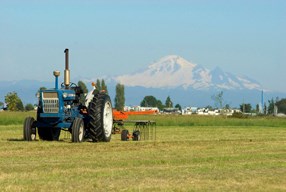From where Jack Zellweger lives, he can see the dikes that hold the line between the land and water. His family has farmed on Westham Island since the 1960s, but as sea levels rise due to climate change, the future of farming here becomes less certain.
"Westham Island is pretty much all below sea level, so it would be bad if the dikes ever breached," says Zellweger, who farms 300 acres, including seed potatoes, beans, peas, grain, hay and beef cattle. "A lot of people think of this area as a bird sanctuary, but this is some of the best farmland in B.C. I'd like to see government make the farmland on Westham Island a priority."
In 2013, Delta farmers were brought together with local and provincial governments by the B.C. Agriculture Food Climate Action Initiative to develop the Delta Regional Adaptation Strategies document to identify and prioritize climate changerelated risks to agriculture in the region. The increased risk of coastal flooding topped the list as a threat to crops, livestock and agricultural infrastructure, with additional concerns about impacts to soils and supply lines.
While agricultural land in this area has always been subject to flood risk, climate change is projected to increase the frequency of flooding associated with extreme weather events, intense precipitation and sea level rise. Sea level in the Fraser delta area is anticipated to rise up to 0.6 metres by 2050, and 1.2 metres by 2100. Rising sea levels, particularly when combined with high tides and storm surges, will increase pressure on coastal marshes, beaches and dikes.
The impacts of climate change on flood risk along the Fraser River side of Delta are less clear. However, with the variability that accompanies climate change, rapid melts and earlier (and more intensive) peak flows are a strong possibility, increasing the potential for flooding along the Fraser River. A recent report, produced as a follow up to the Delta Climate Adaptation Strategies plan, examines the potential economic and agricultural production impacts of flooding related to climate change in the Fraser delta.
While this extent of land would never flood simultaneously, the study found over 6,000 hectares of agricultural land, almost all of the Delta's Agricultural Land Reserve area, is vulnerable to flooding based on projected sea level rise.
Zellweger is philosophical about the likelihood that a major flood will happen anytime soon, but he remembers the last time the dike broke.
"Before the dikes we have today, there were earthen dikes built by the farmers. One year about 30 years ago, we got a bit of a storm and the farmland was flooded by seawater," he recounts. "Our dikes were rebuilt about 25 years ago - it's a good base to work on, but they need to be maintained. That's the cost to keep our farmland in production."
He adds the Corporation of Delta, which is responsible for maintaining the 67 kilometres of dikes that protect the region, will need to upgrade the flood boxes that move water out of low lying areas and beyond the dikes.
For its part, the Corporation of Delta has a long-term strategy as part of its capital works program to raise the dikes ahead of the projected sea level rise. There are also plans on the books to improve pump station capacity to move water out and improve drainage.
"We are taking a long-term, generational approach to dike maintenance, and will raise them by an average 0.6 metres by approximately 2050 to match the climate science," says Hugh Fraser, Delta's deputy director of engineering. "Climate change adaptation projects carry a substantial cost. In Delta alone, a significant investment will be required combined with financial support from senior governments is expected to be required over the next 50 years."
David Ryall, chair of the Delta Farmers' Institute, says the farming community is aware the increase in coastal flood risk due to climate change is more than just an agricultural issue.
"Everybody feels the Corporation of Delta will do something because Ladner is going to be flooded," he says.
"The issue for our farmers is that flooding can damage equipment or buildings, and depending on flooding depth and salinity, some farms could lose a year or more of growth."
While the local government tends to the dikes to protect the community at large, farmers are investing in drainage improvements to move water out to drainage ditches as quickly as possible. Delta farmers are working together to improve their understanding of flood risks by sharing information and enhancing farm-level emergency planning for farms in high-risk areas.
It's part of a long-term strategy to build an agriculture sector that can adapt to changes and remain viable far into the future.
The B.C. Agriculture Food Climate Action Initiative and Delta adaptation projects are supported by funding through Growing Forward 2, a federal, provincial, territorial initiative.
Story submitted by the Delta Farmers' Institute.



